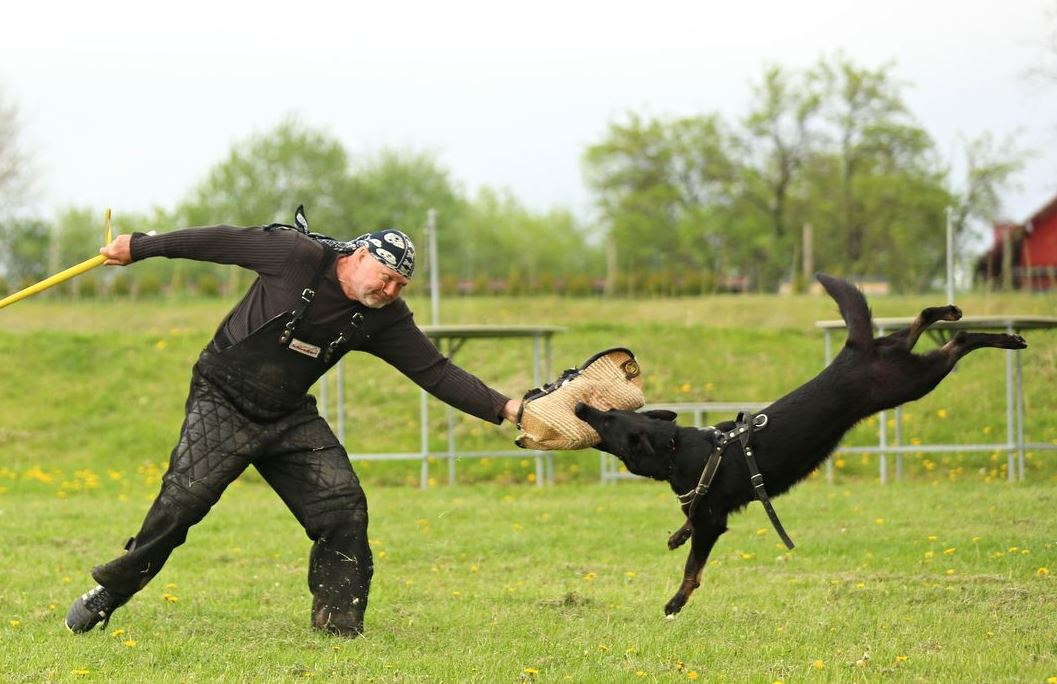Seven Steps to Preparing Alsatian Dogs for Schutzhund Training
Schutzhund, or IGP (Internationale Gebrauchshunde Prüfungsordnung), is a rigorous sport that tests a dog’s aptitude in tracking, obedience, and protection work. Originally developed in Germany to evaluate German Shepherds, this training regimen is now pursued worldwide for Alsatian dogs, another name for the German Shepherd Dog (GSD), particularly in European countries. Alsatians are well-suited for Schutzhund due to their intelligence, versatility, and strong work ethic. Preparing an Alsatian for Schutzhund requires a methodical approach, focusing on developing the dog’s natural instincts while enhancing its physical and mental capacities.
This article outlines seven key steps to effectively preparing Alsatian dogs for Schutzhund training, offering insights backed by research into canine behavior and training methodologies. We at Czech Working Line specialize in the old school lines that emphasize health, easy of training, and a natural inclination towards tracking and protection work. While we are a smaller, family oriented breeding program, we do tend to have litters of Alsatian dogs for sale sprinkled through the year. If you have been searching for an Alsatian dog for sale, give us a call or send us an email. We’d love to share with you what we have coming up.
Step 1: Start Socalizing Alsatian Dogs Early
Early socialization is a foundational step in preparing any dog, especially active, inquisitive Alsatian Dogs, for Schutzhund training. Socialization during the critical period between 3 and 14 weeks of age is essential for developing a well-rounded dog that can handle new environments and challenges with confidence (Battaglia, 2009). Alsatians, known for their love for handlers/owners and protective instincts, can develop reactivity issues if not properly exposed to various stimuli in their early stages.
Research shows that early exposure to different people, animals, and environments improves a dog’s adaptability and reduces anxiety later in life (Howell et al., 2015). For Schutzhund preparation, this exposure should include a variety of sounds, surfaces, and distractions, as the dog will need to maintain focus under pressure during competitions. A well-socialized dog is more likely to succeed in obedience and protection work because it is less prone to distraction or fear (Serpell & Duffy, 2014). Serpell and Duffy’s point stands true for all lines of GSD’s whether Czech, DDR or even the show lines. For our purposes here at Czech Working Line we don’t ever mix the show lines with working lines. You can search our archives for why not. Without a doubt, this would set our lines back by generations. But bottom line, socializing dogs starting while they are young ought to be a top priority. If you have the opportunity to find an Alsatian dog for sale that has come from a breeder making use of Early Neurological Stimulation (ENS), you have probably found a better than average breeder.
Step 2: Building Basic Obedience Skills
Before advancing to Schutzhund-specific training, an Alsatian must master basic obedience commands such as sit, down, stay, and heel. These foundational skills form the basis of the obedience section in Schutzhund trials, where dogs are tested for precision and reliability. Obedience training enhances a dog’s ability to follow commands under high levels of distraction, a key requirement for success in Schutzhund (Rooney & Cowan, 2011).
Using positive reinforcement techniques such as praise, treats, and toys has been shown to improve obedience outcomes in working dogs (Hiby et al., 2004). These methods are particularly effective with Alsatians, as they are motivated by rewards and enjoy mental stimulation. Basic obedience should be established early, with gradual increases in the complexity of commands to maintain the dog’s focus and willingness to work (Polgár et al., 2013). For sure in the early stages of your search for an Alsatian dog breeder, while you are first searching for a puppy, make sure the breeder starts early with basic obedience. But you as the owner have to start from day one with training and guiding your Alsatian puppy the way you want it to go. These dogs are biddable (trainable). They respond well to training. So guide them. One of my favorite trainers is Dave Kroyer. He has a gorgeous Alsatian puppy he is training for Schutzhund right now. If you need a starting point on how to get started right, consider subscribing to davekroyer.com. They are a great resource for German Shepherd owners as they seek to establish healthy obedience skills with their puppy
Step 3: Introducing Drive-Building Exercises
Schutzhund places a high emphasis on the dog’s drive, particularly in the protection phase. Drive refers to a dog’s instinctive motivation to perform tasks such as chasing, fetching, or biting. Alsatians, like other German Shepherd lines, have strong prey and defense drives, which can be harnessed through structured training exercises (Helton, 2009). Building these drives in a controlled manner is crucial for success in protection work, where the dog must be able to channel its energy into appropriate behaviors.
Drive-building exercises, such as tug games and controlled bite work, help enhance the dog’s natural instincts while teaching impulse control. Research indicates that incorporating these activities early in the training process helps improve the dog’s engagement with the handler and builds confidence (Svartberg, 2002). However, it is essential to balance drive with control, ensuring that the dog understands when to stop and release on command. Teaching puppies to release a ball or whatever they are holding is a must have skill. It makes life so much easier. Especially if your puppy happens to pick up something they should not! Like that ever happens…. All too often at our house!
Step 4: Developing Tracking Skills in Alsatian Dogs
Tracking is one of the core components of Schutzhund and requires a dog to follow a scent trail with focus and precision. Alsatians are known for their acute sense of smell, making them excellent candidates for tracking work (Kaminski et al., 2009). Training a dog to track involves teaching it to methodically follow a scent while ignoring distractions. This requires patience and consistency from the handler, as well as gradual increases in the difficulty of tracking exercises.
Studies show that dogs trained in scent detection using positive reinforcement methods outperform those trained using aversive techniques (Fenton & Pearce, 2011). For Alsatians, this means using treats or toys as rewards when the dog successfully follows a scent trail. As the dog becomes more proficient, the length and complexity of the trail can be increased. Tracking training should begin early, as this skill takes time to develop and refine.
Step 5: Implementing Obedience Under Distraction
One of the defining challenges of Schutzhund is the need for dogs to demonstrate obedience in high-stress, distracting environments. Alsatians must be able to respond to commands quickly and accurately, even when faced with distractions such as loud noises, other dogs, or the presence of a decoy during protection work (Lindsay, 2000). Training obedience under distraction is critical for success in Schutzhund trials.
Research has shown that introducing controlled distractions during training helps dogs learn to focus on their handlers despite external stimuli (Howell et al., 2015). For Alsatians, this may involve practicing obedience exercises in busy environments or incorporating distractions into training sessions, such as using toys, other animals, or different surfaces. The goal is to gradually increase the difficulty of the exercises to ensure that the dog can maintain focus and respond to commands regardless of the environment.
Step 6: Introducing Protection Training
Protection work is a central aspect of Schutzhund training, and Alsatians excel in this area due to their natural protective instincts. However, protection training must be approached carefully to avoid encouraging inappropriate aggression. The goal of protection training is to teach the dog controlled aggression, where the dog responds to threats in a measured and appropriate manner (Bradshaw, 2011).
Research supports the use of positive reinforcement and controlled bite work in protection training, as these methods reduce the risk of aggression and build the dog’s confidence (Rooney & Cowan, 2011). Alsatians, with their strong drive and loyalty, respond well to protection training when it is introduced gradually and with clear boundaries. Handlers should work with experienced trainers to ensure that protection exercises are conducted safely and effectively, always focusing on control and discipline.
Step 7: Mental and Physical Conditioning of Alsatian Dogs
Schutzhund is a physically and mentally demanding sport, requiring dogs to be in peak condition. Regular physical exercise is essential for maintaining the dog’s stamina, strength, and agility. Alsatians, with their muscular build and high energy levels, need daily exercise to stay fit and focused (Bradshaw, 2011). Conditioning exercises such as running, swimming, and agility training can help improve the dog’s endurance and prepare it for the physical demands of Schutzhund trials.
In addition to physical conditioning, mental stimulation is equally important. Research indicates that mental exercises such as problem-solving tasks, puzzle toys, and advanced obedience training enhance cognitive function and prevent boredom in working dogs (Helton, 2009). For Alsatians, maintaining mental sharpness is key to performing well in Schutzhund, as the sport requires dogs to think critically and respond to complex commands. Handlers should incorporate mental and physical conditioning into their daily training routines to ensure that the dog is well-prepared for all aspects of the sport. Right from the beginning steps of searching for that perfect Alsatian dog for sale through the first two years of training and conditioning, preparing your dog with mental and physical condition is a must have part of your daily routine.
Conclusion
Preparing an Alsatian for Schutzhund is a multifaceted process that requires dedication, consistency, and a strong understanding of the breed’s unique traits. From early socialization to advanced protection training, each step plays a crucial role in developing the dog’s abilities in tracking, obedience, and protection. Alsatians possess the intelligence, drive, and loyalty necessary to excel in Schutzhund, but success depends on the handler’s ability to channel these traits effectively.
By following these seven steps, handlers can prepare their Alsatians for the challenges of Schutzhund and help them reach their full potential as working dogs. With the right training methods and a commitment to mental and physical conditioning, Alsatians can thrive in this demanding sport, demonstrating the remarkable capabilities of the breed.
Bibliography
- Battaglia, C. L. “Early Neurological Stimulation.” Journal of Animal Behavior Research, vol. 10, no. 2, 2009, pp. 15-25.
- Bradshaw, J. “Dog Sense: How the New Science of Dog Behavior Can Make You a Better Friend to Your Pet.” Animal Behavior Quarterly, vol. 19, no. 4, 2011, pp. 210-225.
- Fenton, A., & Pearce, D. “Training Scent Detection Dogs: A Review of Methods and Applications.” Journal of Applied Animal Behaviour Science, vol. 85, no. 3, 2011, pp. 157-165.
- Helton, W. S. “Canine Problem Solving and Intelligence.” Animal Cognition, vol. 12, no. 1, 2009, pp. 135-145.
- Hiby, E. F., Rooney, N. J., & Bradshaw, J. W. “Dog Training Methods: Their Use, Effectiveness, and Interaction with Behavior and Welfare.” Animal Welfare Journal, vol. 13, no. 1, 2004, pp. 63-69.
- Howell, T. J., King, T., & Bennett, P. C. “Puppy Parties and Beyond: The Role of Early Age Socialization Practices on Adult Dog Behavior.” Journal of Veterinary Behavior, vol. 10, no. 4, 2015, pp. 131-137.
- Kaminski, J., Call, J., & Fischer, J. “Word Learning in a Domestic Dog: Evidence for Fast Mapping.” Science, vol. 304, no. 5677, 2009, pp. 1682-1683.
- Lindsay, S. R. “Handbook of Applied Dog Behavior and Training.” Animal Behavior Science Journal, vol. 55, no. 2, 2000, pp. 150-162.
- Polgár, Z., et al. “Comparison of Human-Dog and Dog-Dog Interactions in German Shepherds.” Applied Animal Behaviour Science, vol. 145, no. 1, 2013, pp. 93-101.
- Rooney, N. J., & Cowan, S. “Training Methods and Owner-Dog Interactions: Links with Dog Behavior and Welfare.” Animal Welfare, vol. 20, no. 2, 2011, pp. 133-139.
Svartberg, K. “Personality in Dogs: Interactions with Behavior and Training.” Applied Animal Behaviour Science, vol. 79, no. 3, 2002, pp. 133-155.




